Pamela S. Douglas, Udo Hoffmann, Manesh R. Patel,

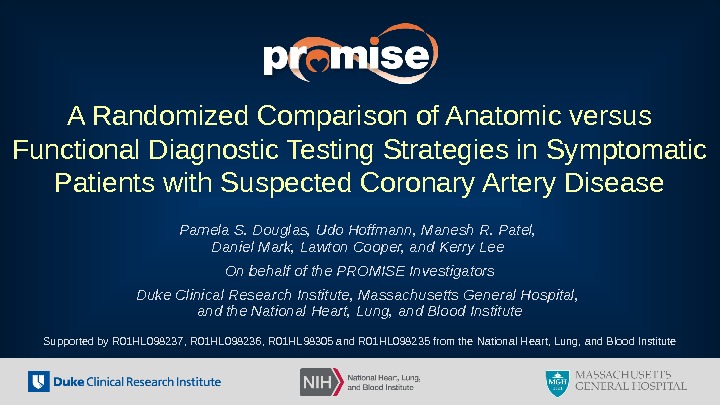

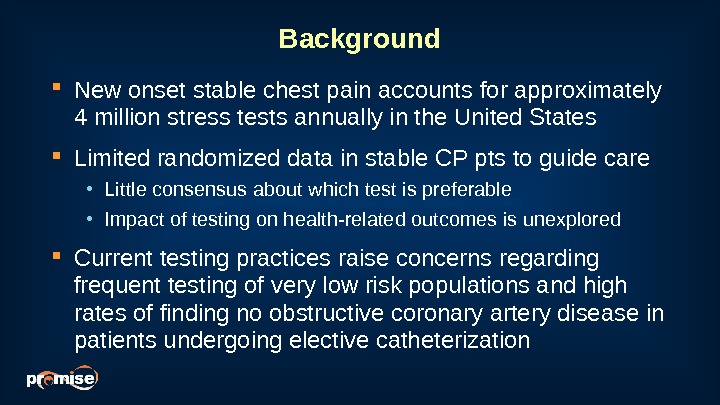
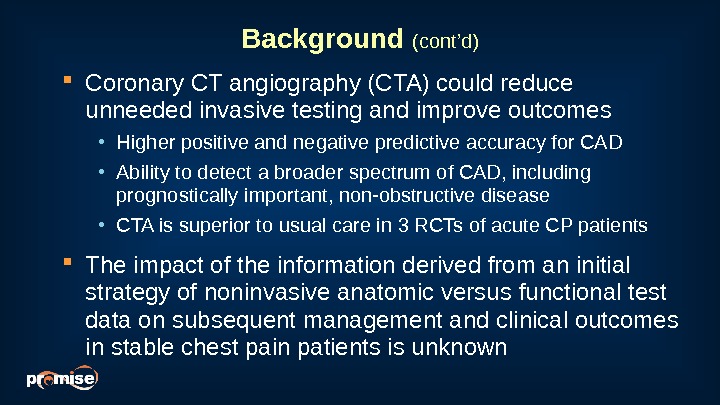


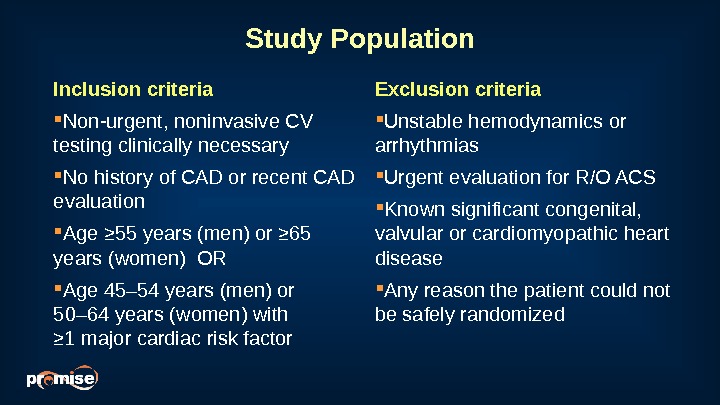

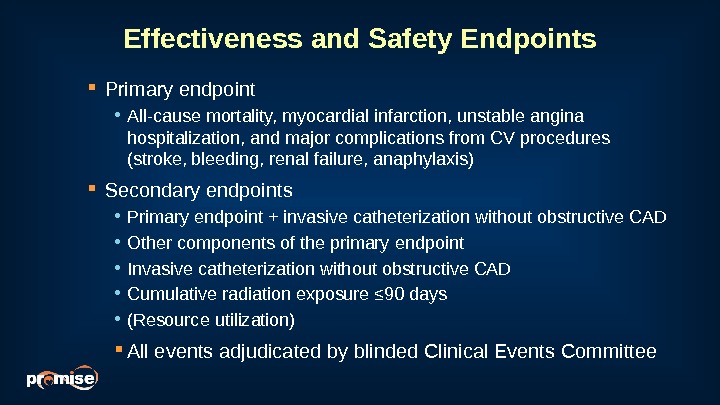
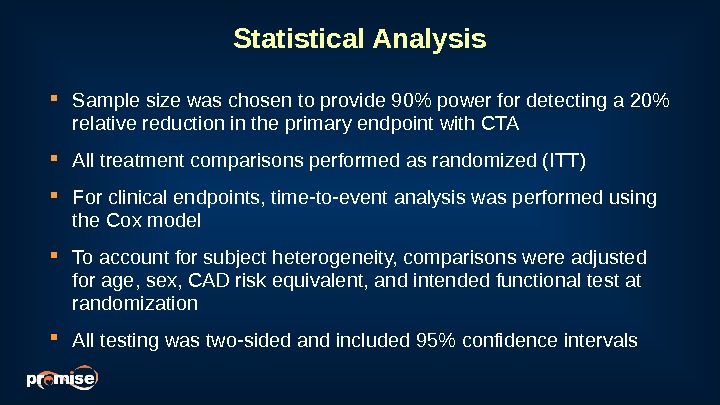


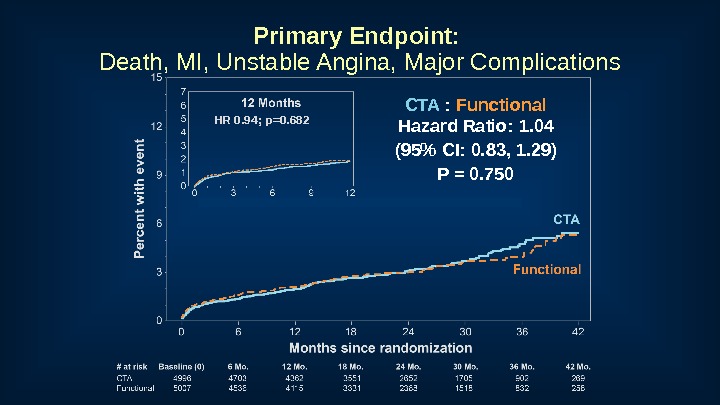

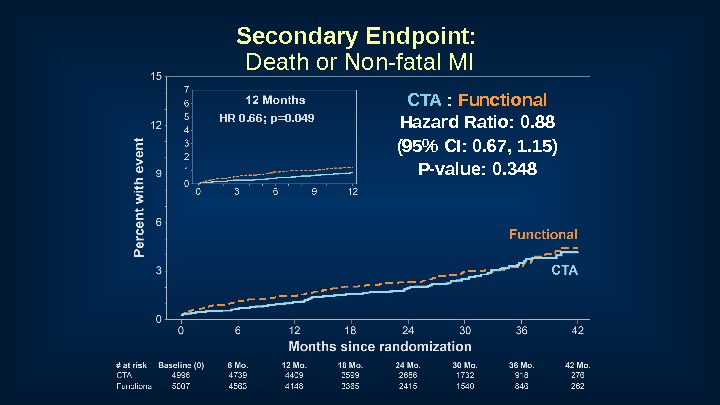

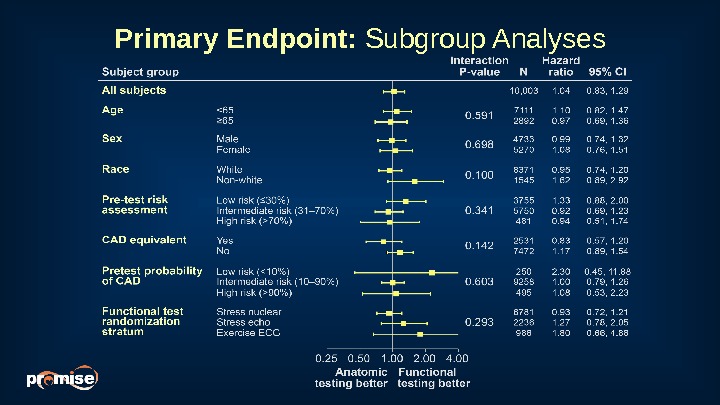
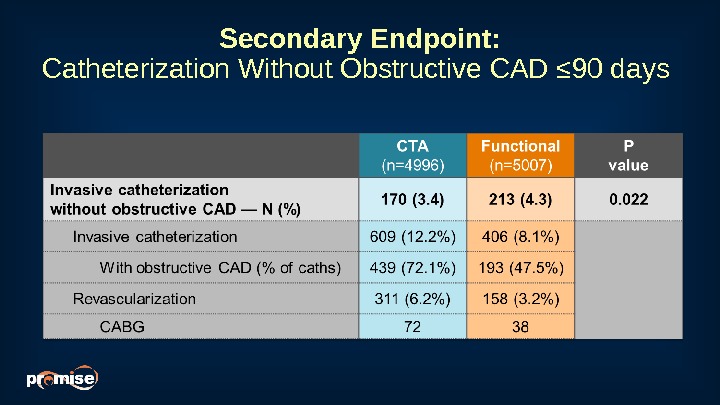
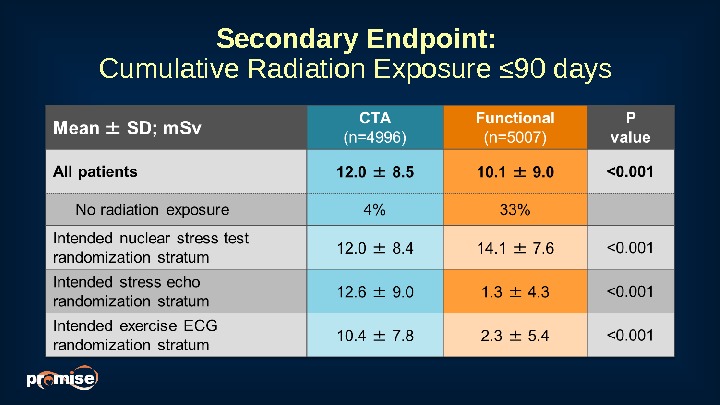

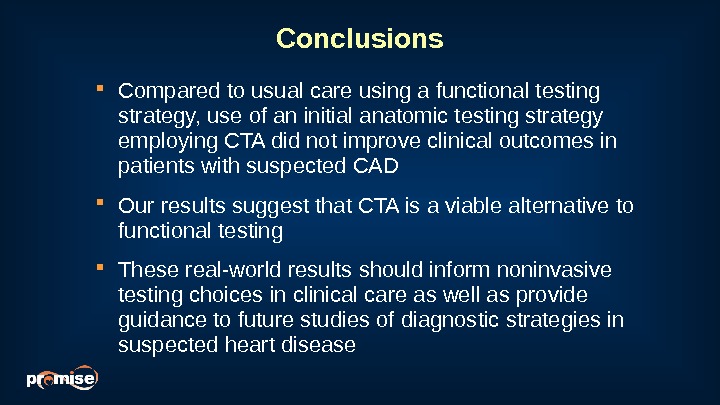
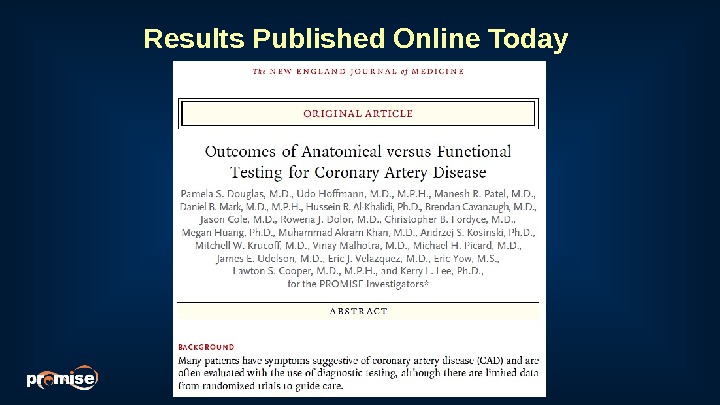

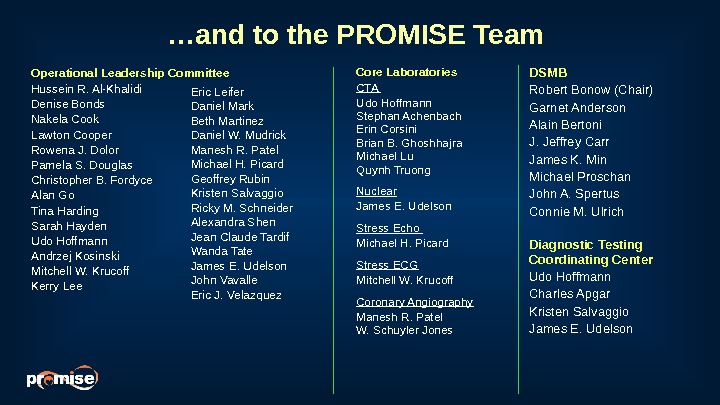

- Размер: 4.4 Mегабайта
- Количество слайдов: 25
Описание презентации Pamela S. Douglas, Udo Hoffmann, Manesh R. Patel, по слайдам
 Pamela S. Douglas, Udo Hoffmann, Manesh R. Patel, Daniel Mark, Lawton Cooper, and Kerry Lee On behalf of the PROMISE Investigators Duke Clinical Research Institute, Massachusetts General Hospital, and the National Heart, Lung, and Blood Institute. A Randomized Comparison of Anatomic versus Functional Diagnostic Testing Strategies in Symptomatic Patients with Suspected Coronary Artery Disease Supported by R 01 HL 098237, R 01 HL 098236, R 01 HL 98305 and R 01 HL 098235 from the National Heart, Lung, and Blood Institute
Pamela S. Douglas, Udo Hoffmann, Manesh R. Patel, Daniel Mark, Lawton Cooper, and Kerry Lee On behalf of the PROMISE Investigators Duke Clinical Research Institute, Massachusetts General Hospital, and the National Heart, Lung, and Blood Institute. A Randomized Comparison of Anatomic versus Functional Diagnostic Testing Strategies in Symptomatic Patients with Suspected Coronary Artery Disease Supported by R 01 HL 098237, R 01 HL 098236, R 01 HL 98305 and R 01 HL 098235 from the National Heart, Lung, and Blood Institute
 Presenter Disclosures Research Grants/Contracts to Institution • Abiomed • Bristol-Meyers Squibb • Columbia University • Gilead • Edwards Lifesciences • Heart. Flow • Ikaria/Bellerophon • Massachusetts General Hospital/Harvard Medical School • National Institutes of Health — NHLBI, NCI, NIAID • Res. Med • Roche • Stealth Peptides • University of South Florida Royalties (<$10, 000) • Up. To. Date / Kluwer
Presenter Disclosures Research Grants/Contracts to Institution • Abiomed • Bristol-Meyers Squibb • Columbia University • Gilead • Edwards Lifesciences • Heart. Flow • Ikaria/Bellerophon • Massachusetts General Hospital/Harvard Medical School • National Institutes of Health — NHLBI, NCI, NIAID • Res. Med • Roche • Stealth Peptides • University of South Florida Royalties (<$10, 000) • Up. To. Date / Kluwer
 Background New onset stable chest pain accounts for approximately 4 million stress tests annually in the United States Limited randomized data in stable CP pts to guide care • Little consensus about which test is preferable • Impact of testing on health-related outcomes is unexplored Current testing practices raise concerns regarding frequent testing of very low risk populations and high rates of finding no obstructive coronary artery disease in patients undergoing elective catheterization
Background New onset stable chest pain accounts for approximately 4 million stress tests annually in the United States Limited randomized data in stable CP pts to guide care • Little consensus about which test is preferable • Impact of testing on health-related outcomes is unexplored Current testing practices raise concerns regarding frequent testing of very low risk populations and high rates of finding no obstructive coronary artery disease in patients undergoing elective catheterization
 Background (cont’d) Coronary CT angiography (CTA) could reduce unneeded invasive testing and improve outcomes • Higher positive and negative predictive accuracy for CAD • Ability to detect a broader spectrum of CAD, including prognostically important, non-obstructive disease • CTA is superior to usual care in 3 RCTs of acute CP patients The impact of the information derived from an initial strategy of noninvasive anatomic versus functional test data on subsequent management and clinical outcomes in stable chest pain patients is unknown
Background (cont’d) Coronary CT angiography (CTA) could reduce unneeded invasive testing and improve outcomes • Higher positive and negative predictive accuracy for CAD • Ability to detect a broader spectrum of CAD, including prognostically important, non-obstructive disease • CTA is superior to usual care in 3 RCTs of acute CP patients The impact of the information derived from an initial strategy of noninvasive anatomic versus functional test data on subsequent management and clinical outcomes in stable chest pain patients is unknown
 PROMISE Study Hypothesis and Design Hypothesis: As compared to functional testing, an initial strategy of anatomic testing with CTA would improve the health outcomes of patients with symptoms suspicious for CAD who require further testing Design: Multicenter, randomized, pragmatic comparative effectiveness trial comparing these two contemporary diagnostic strategies PRO spective M ulticenter I maging S tudy for E valuation of chest pain
PROMISE Study Hypothesis and Design Hypothesis: As compared to functional testing, an initial strategy of anatomic testing with CTA would improve the health outcomes of patients with symptoms suspicious for CAD who require further testing Design: Multicenter, randomized, pragmatic comparative effectiveness trial comparing these two contemporary diagnostic strategies PRO spective M ulticenter I maging S tudy for E valuation of chest pain
 1: 1 Randomization — 10, 000 patients Stratified by site and intended functional test. Symptoms suspicious for significant CAD Requiring non-emergent noninvasive testing 64+ slice CTA Functional strategy Exercise ECG or exercise imaging Pharmacologic stress imaging Tests read locally; Results immediately available Subsequent testing/management by site care team, per guidelines PROMISE Trial Design Minimum follow-up 12 months. Anatomic strategy
1: 1 Randomization — 10, 000 patients Stratified by site and intended functional test. Symptoms suspicious for significant CAD Requiring non-emergent noninvasive testing 64+ slice CTA Functional strategy Exercise ECG or exercise imaging Pharmacologic stress imaging Tests read locally; Results immediately available Subsequent testing/management by site care team, per guidelines PROMISE Trial Design Minimum follow-up 12 months. Anatomic strategy
 Study Population Inclusion criteria Non-urgent, noninvasive CV testing clinically necessary No history of CAD or recent CAD evaluation Age ≥ 55 years (men) or ≥ 65 years (women) OR Age 45– 54 years (men) or 50– 64 years (women) with ≥ 1 major cardiac risk factor Exclusion criteria Unstable hemodynamics or arrhythmias Urgent evaluation for R/O ACS Known significant congenital, valvular or cardiomyopathic heart disease Any reason the patient could not be safely randomized
Study Population Inclusion criteria Non-urgent, noninvasive CV testing clinically necessary No history of CAD or recent CAD evaluation Age ≥ 55 years (men) or ≥ 65 years (women) OR Age 45– 54 years (men) or 50– 64 years (women) with ≥ 1 major cardiac risk factor Exclusion criteria Unstable hemodynamics or arrhythmias Urgent evaluation for R/O ACS Known significant congenital, valvular or cardiomyopathic heart disease Any reason the patient could not be safely randomized
 Study Procedures Diagnostic testing quality control for all modalities • Certification of sites and test readers prior to beginning enrollment • Ongoing quality control throughout the trial Tests performed and interpreted locally • Test information sheets outlining diagnostic and prognostic implications of findings in each modality Site clinical team made all subsequent care decisions; Optimal medical therapy encouraged • Patient and caregiver educational materials
Study Procedures Diagnostic testing quality control for all modalities • Certification of sites and test readers prior to beginning enrollment • Ongoing quality control throughout the trial Tests performed and interpreted locally • Test information sheets outlining diagnostic and prognostic implications of findings in each modality Site clinical team made all subsequent care decisions; Optimal medical therapy encouraged • Patient and caregiver educational materials
 Effectiveness and Safety Endpoints Primary endpoint • All-cause mortality, myocardial infarction, unstable angina hospitalization, and major complications from CV procedures (stroke, bleeding, renal failure, anaphylaxis) Secondary endpoints • Primary endpoint + invasive catheterization without obstructive CAD • Other components of the primary endpoint • Invasive catheterization without obstructive CAD • Cumulative radiation exposure ≤ 90 days • (Resource utilization) All events adjudicated by blinded Clinical Events Committee
Effectiveness and Safety Endpoints Primary endpoint • All-cause mortality, myocardial infarction, unstable angina hospitalization, and major complications from CV procedures (stroke, bleeding, renal failure, anaphylaxis) Secondary endpoints • Primary endpoint + invasive catheterization without obstructive CAD • Other components of the primary endpoint • Invasive catheterization without obstructive CAD • Cumulative radiation exposure ≤ 90 days • (Resource utilization) All events adjudicated by blinded Clinical Events Committee
 Statistical Analysis Sample size was chosen to provide 90% power for detecting a 20% relative reduction in the primary endpoint with CTA All treatment comparisons performed as randomized (ITT) For clinical endpoints, time-to-event analysis was performed using the Cox model To account for subject heterogeneity, comparisons were adjusted for age, sex, CAD risk equivalent, and intended functional test at randomization All testing was two-sided and included 95% confidence intervals
Statistical Analysis Sample size was chosen to provide 90% power for detecting a 20% relative reduction in the primary endpoint with CTA All treatment comparisons performed as randomized (ITT) For clinical endpoints, time-to-event analysis was performed using the Cox model To account for subject heterogeneity, comparisons were adjusted for age, sex, CAD risk equivalent, and intended functional test at randomization All testing was two-sided and included 95% confidence intervals
 Follow-up 12 -month follow-up Completed 4750 (95%) 12 -month follow-up Completed 4600 (92%) Received functional test as 1 st test (n=4692, 94%) Received other test as 1 st test (n=67, 1%) No test (n=248, 5%)Received CTA/CAC as 1 st test (n=4686, 94%) Received other test as 1 st test (n=154, 3%) No test (n=156, 3%)Allocation Median follow-up: 25 months (IQR 18, 34) Maximum follow-up: 50 months Stress nuclear (67%) Stress echo (23%) Ex ECG (10%)Functional testing strategy (n=5007)Anatomic testing strategy (CTA) (n=4996) Randomized (n=10, 003; 193 NA sites; July 2010 – Sept 2013)Randomization and Follow-up
Follow-up 12 -month follow-up Completed 4750 (95%) 12 -month follow-up Completed 4600 (92%) Received functional test as 1 st test (n=4692, 94%) Received other test as 1 st test (n=67, 1%) No test (n=248, 5%)Received CTA/CAC as 1 st test (n=4686, 94%) Received other test as 1 st test (n=154, 3%) No test (n=156, 3%)Allocation Median follow-up: 25 months (IQR 18, 34) Maximum follow-up: 50 months Stress nuclear (67%) Stress echo (23%) Ex ECG (10%)Functional testing strategy (n=5007)Anatomic testing strategy (CTA) (n=4996) Randomized (n=10, 003; 193 NA sites; July 2010 – Sept 2013)Randomization and Follow-up
 Baseline Characteristics
Baseline Characteristics
 Primary Endpoint: Death, MI, Unstable Angina, Major Complications CTA : Functional Hazard Ratio: 1. 04 (95% CI: 0. 83, 1. 29) P = 0. 750 HR 0. 94; p=0.
Primary Endpoint: Death, MI, Unstable Angina, Major Complications CTA : Functional Hazard Ratio: 1. 04 (95% CI: 0. 83, 1. 29) P = 0. 750 HR 0. 94; p=0.
 Secondary Endpoint: Primary Endpoint + Catheterization w/o Obstructive CAD CTA : Functional Hazard Ratio: 0. 91 (95% CI: 0. 78, 1. 06) P-value: 0. 217 HR 0. 85; p=0.
Secondary Endpoint: Primary Endpoint + Catheterization w/o Obstructive CAD CTA : Functional Hazard Ratio: 0. 91 (95% CI: 0. 78, 1. 06) P-value: 0. 217 HR 0. 85; p=0.
 Secondary Endpoint: Death or Non-fatal MI CTA : Functional Hazard Ratio: 0. 88 (95% CI: 0. 67, 1. 15) P-value: 0. 348 HR 0. 66; p=0.
Secondary Endpoint: Death or Non-fatal MI CTA : Functional Hazard Ratio: 0. 88 (95% CI: 0. 67, 1. 15) P-value: 0. 348 HR 0. 66; p=0.
 Clinical Endpoint Events
Clinical Endpoint Events
 Primary Endpoint: Subgroup Analyses
Primary Endpoint: Subgroup Analyses
 Secondary Endpoint: Catheterization Without Obstructive CAD ≤ 90 days
Secondary Endpoint: Catheterization Without Obstructive CAD ≤ 90 days
 Secondary Endpoint: Cumulative Radiation Exposure ≤ 90 days
Secondary Endpoint: Cumulative Radiation Exposure ≤ 90 days
 Summary PROMISE enrolled a symptomatic, intermediate risk population for whom testing is currently recommended There is a low event rate in this contemporary population There were no significant differences in outcomes between an initial anatomic (CTA) or functional testing strategy with respect to the primary endpoint overall or in any subgroup An initial CTA strategy was associated with a lower rate of invasive catheterization without obstructive CAD Radiation exposure was higher in CTA arm overall, but lower in those patients for whom a nuclear test was specified at randomization as the intended functional test, and who were then randomized to CT
Summary PROMISE enrolled a symptomatic, intermediate risk population for whom testing is currently recommended There is a low event rate in this contemporary population There were no significant differences in outcomes between an initial anatomic (CTA) or functional testing strategy with respect to the primary endpoint overall or in any subgroup An initial CTA strategy was associated with a lower rate of invasive catheterization without obstructive CAD Radiation exposure was higher in CTA arm overall, but lower in those patients for whom a nuclear test was specified at randomization as the intended functional test, and who were then randomized to CT
 Conclusions Compared to usual care using a functional testing strategy, use of an initial anatomic testing strategy employing CTA did not improve clinical outcomes in patients with suspected CAD Our results suggest that CTA is a viable alternative to functional testing These real-world results should inform noninvasive testing choices in clinical care as well as provide guidance to future studies of diagnostic strategies in suspected heart disease
Conclusions Compared to usual care using a functional testing strategy, use of an initial anatomic testing strategy employing CTA did not improve clinical outcomes in patients with suspected CAD Our results suggest that CTA is a viable alternative to functional testing These real-world results should inform noninvasive testing choices in clinical care as well as provide guidance to future studies of diagnostic strategies in suspected heart disease
 Results Published Online Today
Results Published Online Today
 THANK YOU to PROMISE Patients and Sites…
THANK YOU to PROMISE Patients and Sites…
 Operational Leadership Committee Hussein R. Al-Khalidi Denise Bonds Nakela Cook Lawton Cooper Rowena J. Dolor Pamela S. Douglas Christopher B. Fordyce Alan Go Tina Harding Sarah Hayden Udo Hoffmann Andrzej Kosinski Mitchell W. Krucoff Kerry Lee Eric Leifer Daniel Mark Beth Martinez Daniel W. Mudrick Manesh R. Patel Michael H. Picard Geoffrey Rubin Kristen Salvaggio Ricky M. Schneider Alexandra Shen Jean Claude Tardif Wanda Tate James E. Udelson John Vavalle Eric J. Velazquez… and to the PROMISE Team DSMB Robert Bonow (Chair) Garnet Anderson Alain Bertoni J. Jeffrey Carr James K. Min Michael Proschan John A. Spertus Connie M. Ulrich Diagnostic Testing Coordinating Center Udo Hoffmann Charles Apgar Kristen Salvaggio James E. Udelson. Core Laboratories CTA Udo Hoffmann Stephan Achenbach Erin Corsini Brian B. Ghoshhajra Michael Lu Quynh Truong Nuclear James E. Udelson Stress Echo Michael H. Picard Stress ECG Mitchell W. Krucoff Coronary Angiography Manesh R. Patel W. Schuyler Jones
Operational Leadership Committee Hussein R. Al-Khalidi Denise Bonds Nakela Cook Lawton Cooper Rowena J. Dolor Pamela S. Douglas Christopher B. Fordyce Alan Go Tina Harding Sarah Hayden Udo Hoffmann Andrzej Kosinski Mitchell W. Krucoff Kerry Lee Eric Leifer Daniel Mark Beth Martinez Daniel W. Mudrick Manesh R. Patel Michael H. Picard Geoffrey Rubin Kristen Salvaggio Ricky M. Schneider Alexandra Shen Jean Claude Tardif Wanda Tate James E. Udelson John Vavalle Eric J. Velazquez… and to the PROMISE Team DSMB Robert Bonow (Chair) Garnet Anderson Alain Bertoni J. Jeffrey Carr James K. Min Michael Proschan John A. Spertus Connie M. Ulrich Diagnostic Testing Coordinating Center Udo Hoffmann Charles Apgar Kristen Salvaggio James E. Udelson. Core Laboratories CTA Udo Hoffmann Stephan Achenbach Erin Corsini Brian B. Ghoshhajra Michael Lu Quynh Truong Nuclear James E. Udelson Stress Echo Michael H. Picard Stress ECG Mitchell W. Krucoff Coronary Angiography Manesh R. Patel W. Schuyler Jones


